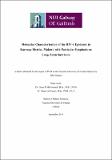| dc.contributor.advisor | McCormack, Grace | |
| dc.contributor.advisor | Travers, Simon | |
| dc.contributor.author | Seager, Ishla | |
| dc.date.accessioned | 2012-11-08T16:53:24Z | |
| dc.date.available | 2012-11-08T16:53:24Z | |
| dc.date.issued | 2012-06-14 | |
| dc.identifier.uri | http://hdl.handle.net/10379/3049 | |
| dc.description.abstract | HIV-1 has been studied in the Karonga District in northern Malawi for almost 30 years (1982-2010). Within Karonga a cohort of subtype C long-term survivors were identified who have been followed for over 20 years with samples collected at approximately four time points. From these gag and env sequences have been generated. A three amino acid deletion previously described from these LTS was found to be error. Over the sampling time points a number of unlikely amino acid changes were seen within the generated sequences. A wide range of diversity was detected in a number of LTS from the same time point including two individuals who are possibly superinfected with two viral strains. Clonal sequences generated from the LTS showed some LTS to have highly homogenous viral populations and others to more heterogeneous populations. Most LTS showed an increase in divergence from the first sampling time point. CXCR4 tropic viruses were detected in over 50 % of the subtype C LTS.
This work also describes the HIV-1 epidemic in Karonga by comparing sequences collected in the 1990s and 2000s to those collected in the 1980s. The prevalence of Subtype C was 91 % in the 1990s and 93 % by the 2000s. A number of recombinant viruses were also identified including three A1/C recombinants that contained an identical breakpoint within gag. Phylogenetic analysis of the subtype C variants identified two patterns of circulation within the viral population in Karonga (i) a number of related, geographically restricted viruses, and (ii) introduction of new subtype C variants from the surrounding regions resulting in a highly diverse population. The mean genetic diversity in subtype C Karonga increased from 5.75 % to 7.84 % in gag (p17/p24) and 10.05 % to 13.60 % in env (C2-V3) from the 1982-2000 to the late 2000s. The range of divergence from a subtype C common ancestor was also seen to increase. Genotypic co receptor tropism prediction tools identified an increase in the prevalence of CXC4 tropic viruses from 3.9 % in the 1980s to 24.7 % in the 2000s. | en_US |
| dc.rights | Attribution-NonCommercial-NoDerivs 3.0 Ireland | |
| dc.rights.uri | https://creativecommons.org/licenses/by-nc-nd/3.0/ie/ | |
| dc.subject | HIV-1 | en_US |
| dc.subject | Natural Sciences | en_US |
| dc.title | Molecular Characterisation of the HIV-1 Epidemic in Karonga District, Malawi, with Particular Emphasis on Long-Term Survivors | en_US |
| dc.type | Thesis | en_US |
| dc.contributor.funder | IRCSET | en_US |
| dc.local.final | Yes | en_US |
| nui.item.downloads | 280 | |


